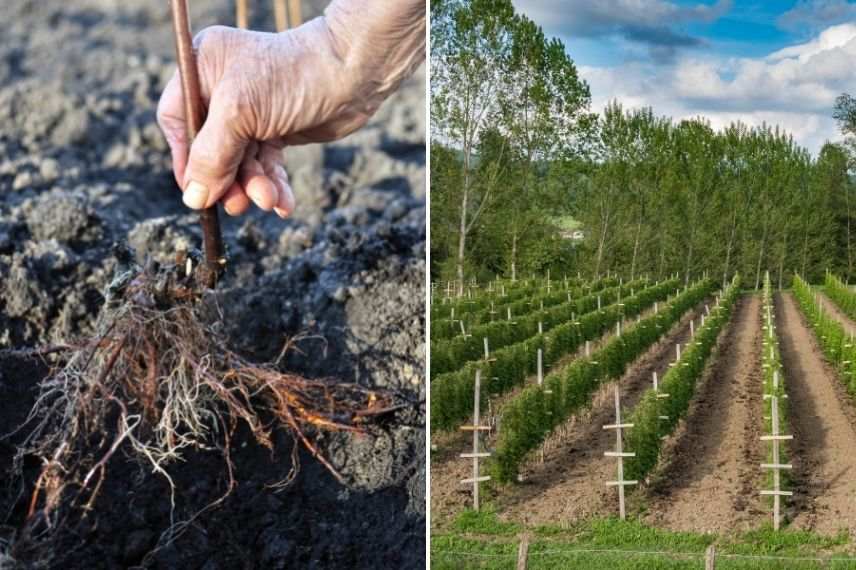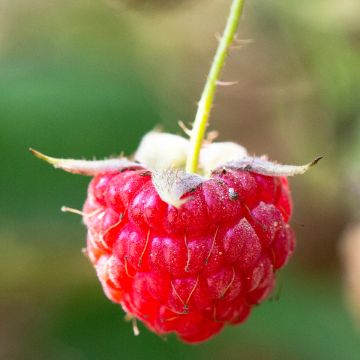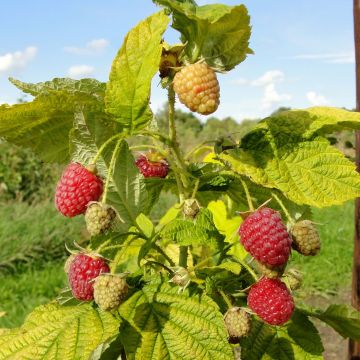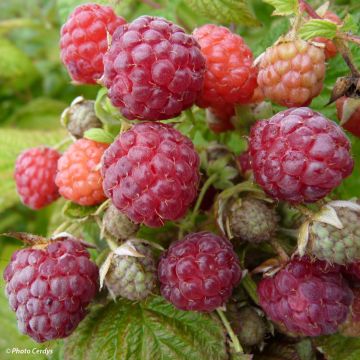
Planting bare root raspberries
When and how to do it?
Contents
You have chosen to buy your raspberry as bare roots, and many questions may arise regarding their planting. Although planting raspberry plants is not complicated, there are a few tips to know. While the bare root condition ensures good establishment and growth of the plants, it is essential to prepare and soak the roots before planting. Moreover, for optimal fruiting, staking is obligatory. Finally, the pruning will differ depending on the type of variety: repeat flowering or non-repeat flowering. So, to make the most of these little red fruits during the summer and prepare delicious raspberry tarts and jams, or simply to enjoy them in a fruit salad, here are our tips for successfully planting raspberry plants as bare roots.
When to plant bare root raspberries?
Raspberry plants with bare roots are best planted from October to March. They are in dormancy during this period. Planting should not be carried out in cases of frost, snowfall, or if the soil is waterlogged. These conditions can jeopardise the establishment of the plant.
Read also
Choosing raspberry plantsWhere to plant a raspberry bush?
To have sweet raspberries, plant your raspberry bush in a bright but not scorching location. In the hottest regions, it is better to place it in partial shade. It is also possible to plant a raspberry bush at the foot of an east-facing wall where it will be sheltered from the strong afternoon sun and the wind.
The raspberry bush prefers soils rich in humus, cool, light, and not too calcareous. If your soil tends to be clayey, add sand to lighten it. In the case of calcareous soil, lower its pH by acidifying it with compost, which can fertilise the soil while improving its structure. Organic mulching, such as resinous wood chips, can also help to acidify the soil.

Discover other Raspberry plants
View all →Available in 0 sizes
Available in 0 sizes
Available in 1 sizes
Available in 2 sizes

Available in 2 sizes
Available in 1 sizes
Available in 2 sizes
Available in 3 sizes
Available in 1 sizes
Available in 1 sizes
How to plant bare root raspberries?
The necessary equipment
- raspberry plants with bare roots
- gloves
- pruning shears
- large bucket or bin
- cow dung, manure or ready-to-use pralin
- spade or fork, trowel
- compost or potting soil
- string line
- watering can
- mulch
Preparing the roots
Before planting, it is essential to prepare the roots. This light pruning of the roots stimulates the growth of root hairs. To do this, check that the roots are healthy and show no signs of fungus. Using a well-disinfected and sharpened pruning shear, remove any dried or damaged roots. To achieve a homogeneous root system, shorten any excessively long roots. Note: suckers are present at the base of the raspberry stem. Handle your plants carefully to avoid damaging these suckers, which will develop into canes bearing fruit.
Preparing the pralin
Pralin is a technique that involves soaking the plant’s roots in a muddy mixture to rehydrate them, promote healing, and increase the chances of successful establishment. Ideally, pralin should be done 24 hours before planting. Here’s our recipe for preparing pralin:
- In a bucket, place ⅓ garden soil, ⅓ fresh cow dung or fresh horse manure, and ⅓ rainwater.
- Mix everything until you obtain a thick, creamy mixture that adheres well to the roots.
- Submerge the raspberry roots in the pralin to coat them thoroughly.
- Let them soak until the next day.
Tip: well-decomposed compost or pelletised manure can effectively replace cow dung.
Planting raspberry plants with bare roots
Like all plants with bare roots, the raspberry must be planted as soon as possible after receipt, as roots exposed to air dry out quickly! Not tolerating heavy, compact, and overly moist soils, soil preparation should not be neglected before planting raspberries.
- Loosen the soil to a depth of about 30 cm and a width of 40 cm. This corresponds to the size of the trench that will accommodate your raspberries in a row.
- Remove large stones and weeds.
- Dig your trench. Incorporate compost or manure and mix. The soil should be well loosened.
- Shorten the stems of your raspberries to 20 cm above the collar.
- Place your raspberries in a line, at the centre of the trench. You can use a taut string line to align them properly. Space your plants 50 cm apart. If you wish to plant several rows of raspberries, ensure there is at least 1.5 m between each row.
- Add compost or manure to the extracted soil and refill the trench.
- Gently compact with your foot and check that the collar of the raspberries is level with the soil surface.
- Create a basin around the raspberries and water generously.
- Apply a layer of mulch (such as leaves, straw, bark, wood chips…) to prevent weeds from growing in early spring.
- Note that it is also possible to plant a mixed fruit hedge by combining raspberries with other fruiting bushes.

Check the condition of the roots before planting and respect the planting distances between plants and rows.
Read also
How to grow raspberry in a pot?How to train raspberries?
Staking should be done at planting. It allows the raspberry plant to benefit from optimal light and facilitates the harvesting of raspberries. Indeed, the canes are kept upright and do not sag. There are different staking methods for raspberries: fan training, Dutch training, free-standing clump training, and staking on posts. You will need tools and materials such as stakes, wire, clips, ties, saw, drill, or mallet.
⇒ Check our article for properly staking raspberries.

Fan training
Caring for raspberries
- Watering raspberry plants should be regular during the first year of planting, especially in hot weather, as raspberries do not tolerate drought. The soil should always remain slightly moist. In subsequent years, water only during periods of intense heat.
- Remember to guide the canes on the trellis as they grow and secure them with ties. You can also check the anchoring of your stakes or re-tension the wires if necessary.
- Apply aspecial fertiliser for soft fruits in spring, as raspberries are nutrient-hungry and require nutrients. In autumn, you should provide compost or manure.
- Top up the mulch as needed, as it degrades gradually over time.
- For good fruiting, raspberries need to be pruned. During the two winters following planting, cut the dry stems back to ground level and trim the new shoots to 60 cm above the ground. Afterwards, depending on the type of raspberry (repeat flowering or not), the pruning will differ. Repeat flowering varieties produce fruit twice a year, in June and then from August to October. Their shoots develop, flower, and bear fruit in the same year. Non-repeat flowering varieties only fruit once in June-July, but the harvest is abundant. Their shoots develop in the first year and flower in the second year in May before producing fruit.
- Monitor the condition of your plants. Some diseases affect raspberries, such as botrytis or rust, and they can also be attacked by pests.
- Finally, raspberries tend to spread. Therefore, it is necessary to contain them by removing the suckers that appear outside the rows, using a spade.
⇒ Find all the information regarding raspberry pruning in our article.
⇒ All our tips for preventing and treating raspberry diseases.
- Subscribe!
- Contents








































Comments